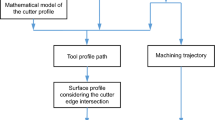Abstract
Traditional peripheral milled surface models, whether resulting from analytical or numerical method, are targeted at solving numerical points of the surface. However, the independent coordinate point is lack of geometric or physical meaning due to its incompetence of description for milled surface geometry and connection with milling conditions, unless all the discrete points are engaged. Such surface characterization or the corresponding modelling method based on point is flawed inherently that lead to its less suitable for study of surface parameters or effect factors. Therefore, a new idea and methodology are introduced. Firstly, geometric feature element of the peripheral milling surface is defined, by analyzing periodic feature of the surface residue profile in stable milling process with the presence of cutter runout. Then, taking three and four teeth cutter milling situations as example, systematic theories and methods are developed for calculating and analyzing of the feature element. Thirdly, via simulation tests of milled surface geometry, superior modelling performance in accuracy and efficiency of the feature-based method are verified in contrast with the integrated analytic and numerical method, the simulated surface based on which is perceived as the theoretical true result. All the effort devoted to this new idea proves that the defined geometric feature element is qualified for characterization of milled surface geometry, which not only improves the surface model but also will be convenient to the further study in surface quality and functionality.














Similar content being viewed by others
References
Martellotti ME (1941) An analysis of the milling process. Trans ASME 63:677–700
Martellotti ME (1945) An analysis of the milling process, part ii-down milling. Trans ASME 67:233–251
Kline WA, Devor RE, Shareef IA (1982) The prediction of surface accuracy in end milling. ASME J Eng Ind 104(3):272–278
Babin TS, Lee JM, Sutherland JW, Kapoor SG (1985) A model for end milled surface topography. Manufacturing Engineering Transactions pp. 362-368
Sutherland JW, DeVor RE (1986) An improved method for cutting force and surface error prediction in flexible end milling system. ASME J Eng Ind 108:269–279
Armarego EJA, Deshpande NP (1989) Computerized predictive cutting models for forces in end-milling including eccentricity effects. CIRP Ann Manuf Technol 38(1):45–49
Spiewak SA (1994) Analytical modeling of cutting point trajectories in milling. J Eng Indust 116(4):1601–1609
Rao VS, Rao PVM (2005) Modelling of tooth trajectory and process geometry in peripheral milling of curved surfaces. Int J Mach Tools Manuf 45(6):617–630
Li HZ, Li XP (2005) A numerical study of the effects of cutter runout on milling process geometry based on true tooth trajectory. Int J Adv Manuf Technol 25(5–6):435–443
Kumanchik LM, Schmitz TL (2007) Improved analytical chip thickness model for milling. Precis Eng 31(3):317–324
Sai L, Bouzid W, Zghal A (2008) Chip thickness analysis for different tool motions: for adaptive feed rate. J Mater Process Technol 204(1-3):213–220
Zhang X, Zhang J, Zhao WH (2016) A new method for cutting force prediction in peripheral milling of complex curved surface. Int J Adv Manuf Technol 86(1-4):117–128
Gao T, Zhang W, Qiu K, Wan M (2006) Numerical simulation of machined surface topography and roughness in milling process. J Manuf Sci Eng 128(1):96–103
Arizmendi M, Campa FJ, Fernández J, de Lacalle LL, Gil A, Bilbao E, Veiga F, Lamikiz A (2009) Model for surface topography prediction in peripheral milling considering tool vibration. CIRP Ann Manuf Technol 58(1):93–96
Desai KA, Agarwal PK, Rao PVM (2009) Process geometry modeling with cutter runout for milling of curved surfaces. Int J Adv Manuf Technol 49(12):1015–1028
Arizmendi M, Fernández J, Gil A, Veiga F (2010) Model for the prediction of heterogeneity bands in the topography of surfaces machined by peripheral milling considering tool runout. Int J Mach Tools Manuf 50(1):51–64
Arizmendi M, Fernández J, Gil A, Veiga F (2010) Identification of tool parallel axis offset through the analysis of the topography of surfaces machined by peripheral milling. Int J Mach Tools Manuf 50(12):1097–1114
Buj-Corral I, Vivancos-Calvet J, González-Rojas H (2011) Influence of feed, eccentricity and helix angle on topography obtained in side milling processes. Int J Mach Tools Manuf 51(12):889–897
Buj-Corral I, Vivancos-Calvet J, González-Rojas H (2013) Roughness variation caused by grinding errors of cutting edges in side milling. Mach Sci Technol 17(4):75–592
Krüger M, Denkena B (2013) Model-based identification of tool runout in end milling and estimation of surface roughness from measured cutting forces. Int J Adv Manuf Technol 65(5-8):1067–1080
Zhang L, Zheng GL, Shi YN, Yang RR (2017) Improved tooth trajectory model for prediction of milled surface geometry. Mach Sci Technol 21(2):175–201
Author information
Authors and Affiliations
Corresponding author
Additional information
Publisher’s note
Springer Nature remains neutral with regard to jurisdictional claims in published maps and institutional affiliations.
Rights and permissions
About this article
Cite this article
Zhang, L., Zheng, G. & Yang, R. General characterization of peripheral milled surface geometry by feature element. Int J Adv Manuf Technol 105, 4809–4825 (2019). https://doi.org/10.1007/s00170-019-04474-8
Received:
Accepted:
Published:
Issue Date:
DOI: https://doi.org/10.1007/s00170-019-04474-8



